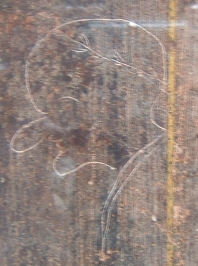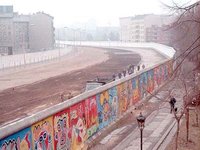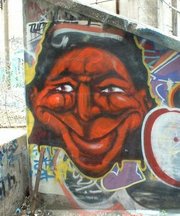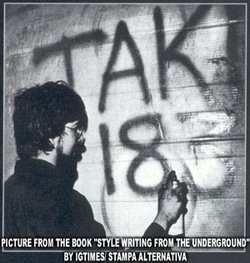Graffiti
|
|
- For the handwriting system, see Graffiti (Palm OS).
Graffiti is a type of deliberately inscribed marking made by humans on surfaces, both private and public. It can take the form of art, drawings, or words. When done without a property owner's consent it constitutes illegal vandalism. Graffiti has existed at least since the days of ancient civilizations such as classical Greece and the Roman Empire.
The word "graffiti" expresses the plural of "graffito", although the singular form has become obscure and has largely fallen into disuse. Both of these English words come from the Italian language, most likely descending from "graffiato", the past participle of "graffiare" (to scratch); ancient graffitists scratched their work into walls before the advent of spray-paint. These words derive in their turn from the Greek γραφειν (graphein), meaning "to write". Historians continue to speculate over the vexed question as to where the term "graffiti" first referred to this form of marking.
Graffiti_Panorama_rome.jpg
| Contents |
History of graffiti
Ancient times

Historically, the term graffiti originally referred to the inscriptions, figure drawings, etc., found on the walls of ancient sepulchers or ruins, as in the Catacombs of Rome or at Pompeii. Usage of the word has evolved to include any decorations (inscribed on any surface) that one can regard as vandalism; or to cover pictures or writing placed on surfaces, usually external walls and sidewalks, without the permission of an owner. Thus, inscriptions made by the authors of a monument do not class as graffiti.
The first known example of "modern style" graffiti survives in the ancient Greek city of Ephesus (in modern-day Turkey) and appears to advertise prostitution, according to the tour guides of the city. It stands near the long mosaic and stone walkway and consists of a handprint, a vaguely heart-like shape, a footprint and a number. This purportedly indicates how many steps one would have to take to find a lover, with the handprint indicating payment.

The Romans carved graffiti into their own walls and monuments, and examples of their work also exist in Egypt. The eruption of Vesuvius preserved graffiti carved on the walls of Pompeii, and they offer us a direct insight into street life: everyday Latin, insults, magic, love declarations, political consigns. Hadrian's Villa at Tivoli also has several examples. One example has even survived that warns: "Cave Canem", which translates as "Beware of the dog," next to a picture of the dog in question.
However not only Greeks and Romans produced graffiti: the Mayan site of Tikal in Guatemala, also contains ancient examples. Viking graffiti survive in Rome and at Newgrange Mound in Ireland, and Varangians carved their runes in Hagia Sophia in Constantinople. The Ancient Irish inscribed stones with an alphabet called Ogham -- this standard mode of writing may not classify as graffiti.
Later, French soldiers carved their names on monuments during the Napoleonic campaign of Egypt in the 1790s.
Art forms like frescoes and murals involve leaving images and writing on wall surfaces. Like the prehistoric wall paintings created by cave dwellers, they do not comprise graffiti, as the artists generally produce them with the explicit permission (and usually support) of the owner or occupier of the walls.
Modern times
GraffitiArtist.jpg
In the 20th century, especially during World War II, 'Kilroy was here' became a famous graffito, along with Mr. Chad, a face with only the eyes and a nose hanging over the wall, saying "What No [scarce commodity]…?" during the time of rationing. Twentieth century warfare saw the advent of many new aviation technologies, closely followed by the advent of airplane graffiti, including the nose art made famous during World War II.
Starting with the large-scale urbanization of many areas in the post-war half of the 20th century, urban gangs would mark walls and other pieces of public property with the name of their gang (a "tag") in order to mark the gang's territory. Near the end of the 20th century, non-gang-related tagging became more common, practised for its own sake. Graffiti artists would sign their "tags" for the sake of doing so and sometimes to increase their reputation and prestige as a "writer" or a graffiti artist.
Taggers sometimes select tags, like screennames, to reflect some personal qualities. Some tags also contain subtle and often cryptic messages. The year in which the piece was created, and in some cases the writer's initials or other letters, sometimes become a part of the tag. In some cases, "writers" dedicate or create tags or graffiti in memory of a deceased friend, for example: "DIVA Peekrevs R.I.P. JTL '99".
In some cases, taggers achieve such elaborate graffiti (especially those done in memory of a deceased person) on storefront gates that shopkeepers have hesitated to clean them off. In the Bronx after the death of rapper Big Pun, several murals dedicated to his life appeared virtually overnight; similar outpourings occurred after the deaths of The Notorious B.I.G. and Tupac Shakur.
Ber93.jpg
Some graffiti has local or regional resonance, such as wall and street sign tagging in Southern California by gangs such as the Bloods and the Crips. The name Cool "Disco" Dan (including the quotation marks) occurs commonly in the Washington, D.C. area. One famous graffito in the DC Metro area appeared on the outer loop of the beltway on a railroad bridge near the Mormon temple as seen here (http://www.lds.org/multimedia/files//5310_WASHINGTONDC_hr.jpg). Its simple scrawl "Surrender Dorothy" summoned visions of the Emerald City of Oz and has remained on the bridge for nearly 30 years off and on beginning in late 1973. Pressure from the Temple saw it removed, only to reappear. This "giraffiti" became so well known among the Mormon community that their newsletters often mentioned it as a specific example demonstrating misunderstanding. (See "In View of Temple, Graffiti Again Seeks Dorothy's Surrender" (http://www.mormonstoday.com/011207/D1WashDCTemple01.shtml) and "Landmark to most, temple is sanctuary for area's Mormons" (http://www.mormonstoday.com/991114/D1WashingtonTemple01.shtml) in Mormons Today.)
Theories on and the use of graffiti by avant-garde artists have a history dating back at least to the Scandinavian Institute of Comparative Vandalism of 1961.
Some of those who practise graffiti art wish to distance themselves from gang graffiti. Differences in both form and intent exist: graffiti art (its practioners claim) aims at self-expression and creativity, and may involve highly stylized letter-forms drawn with markers, or cryptic and colorful spray paint murals on walls, buildings, and even freight trains. Graffiti artists strive to improve their art, which constantly changes and progresses. Gang graffiti, on the other hand, functions to mark territorial boundaries, and therefore does not transcend a gang's neighborhood; it does not (in the eyes of lovers of graffiti-art) presuppose artistic intent.
The designs, while chosen to appear distinctive and recognizable, are more likely to be influenced by the speed with which a tagger can execute them (thus minimizing the chance of that tagger getting caught). Those who distinguish between tagging and graffiti generally accept tagging as gang-motivated or meant as vandalism (illegal) or viewed as too vulgar or controversial to have public value, while they can view graffiti as creative expression, whether charged with political meaning or not.
Many contemporary analysts and even art critics have begun to see artistic value in some graffiti and to recognize it as a form of public art.According to many art researchers, particularly in the Netherlands and in Los Angeles, that type of public art is, in fact an effective tool of social emancipation or in the achievement of a political goal.
The murals of Belfast and of Los Angeles [1] (http://rpmurals.home.att.net/) offer another example of official recognition. In times of conflict, such murals have offered a means of communication and self-expression for members of these socially, ethnically and/or racially divided communities, and have proven themselves as effective tools in establishing dialog and thus of addressing cleavages in the long run.
Graffiti.jpg
Terminology
A number of words and phrases have come to describe different styles and aspects of graffiti:
- tag - a stylized signature; the terms tagger and writer refer to a person who "tags"
- piece (from "masterpiece") - a large image, often with 3-Dd effects, arrows giving flow and direction, many colours and colour-transitions and various other effects. A piece needs more time than a throw-up. If placed in a difficult place and well executed it will earn the writer more respect
- throw-up - not a piece, but more of a large tag. It often has an outline (like black) and a fill-colour (like silver). Easy-to-paint bubble-shapes often form the letters
- bombing (as in the phrases to bomb or to hit) has no connection with terrorism, but describes painting many surfaces. Throw-ups often serve for this, since they don´t require much time to execute
- crew has become the standard collective noun for a group of writers or graffiti-artists
- writers become up when their work becomes widespread and well-known. To "get up" in a city involves both tagging, bombing and making good pieces
- to slash somebody's tag (to put a line through, or tag over it) counts as a deep insult.
- the phrase back to back refers to a graffiti that covers a wall from end to end, as seen on some parts of the West-Berlin side of the Berlin Wall. Similarly, trains sometimes receive end to end painting.
- burner - typically a large, elaborate piece, more elaborate than a normal piece. It refers to the piece "burning" out of the wall or trainside. Burners often originate legally, because of the time and effort put into them, but the great early writers of New York also did burners illegally on trains.
Informal competition sometimes exists between taggers as to who can put up the most, or the most visible or artistic tags (see the section below titled Graffiti art battle). Writers with the most tags up tend to gain respect among other graffiti artists, although they will also incur a greater risk if caught by authorities.
To gain notoriety, and make pieces difficult to remove, graffiti artists will sometimes paint hard-to-reach spots such as rooftops. Such heavens pieces (also commonly known as giraffiti), and by the nature of the spot often pose dangerous challenges to execute.
Another technique sometimes referred to as "scratchitti" involves making purposely hard-to-remove graffiti by scratching or etching a tag into an object, generally using a key or another sharp object such as a knife or a stone.
Legal situation
Graffiti is subject to different societal pressures from popularly-recognized art forms, since graffiti appears on walls, freeways, buildings, trains or any accessible surfaces that are not owned by the person who applies the graffiti. This means that graffiti forms incorporate elements rarely seen elsewhere. Spray paint and broad permanent markers are commonly used, and the organizational structure of the art is sometimes influenced by the need to apply the art quickly before it is noticed by authorities.
In an effort to reduce vandalism, many cities have designated walls or areas exclusively for use by graffiti artists. Some have suggested that this discourages petty vandalism yet encourages artists to take their time and produce great art, without worry of being caught or arrested for vandalism or trespassing. Others disagree with this approach, arguing that the presence of legal graffiti walls does not demonstrably reduce illegal graffiti elsewhere.
Many people regard graffiti as an unwanted nuisance, or as expensive vandalism requiring repair of the vandalised property. One can view graffiti as a 'quality of life' issue, and many people suggest that the presence of graffiti contributes to a general sense of squalor and a heightened fear of crime. Advocates of the "broken window theory" believe that this sense of decay encourages further vandalism and promotes an environment leading to the committing of more serious offences. Former New York City mayor Rudy Giuliani's subscription to the broken window theory promoted an aggressive anti-graffiti campaign in New York. But throughout the world, authorities often - but not always - treat graffiti as a minor nuisance crime, though with widely varying penalties.
Community cleaning squads have responded to graffiti. In France, the Protestant youth group Éclaireurs de France took their graffiti-scrubbing into the Meyrieres Cave near the French village of Bruniquel in Tarn-et-Garonne, where they carefully erased the ancient paintings from the walls, earning them the 1992 Ig Nobel Prize in archaeology.[2] (http://www.improb.com/ig/ig-pastwinners.html#ig1992)
Us-nogutsnofame.JPG
Graffiti made the news in 1993, over an incident in Singapore involving several expensive cars found spray-painted. The police arrested a student from Singapore American School, Michael P. Fay, questioned him and subsequently charged him with vandalism. Fay pleaded guilty for vandalizing the car in addition to stealing road signs. Under the 1966 Singapore Vandalism Act, originally passed to curb the spread of communist graffiti in Singapore, the court sentenced him to four months in jail, a fine of 3,500 Singaporean dollars (US $2,233 or 1,450 British pounds), and a caning. The New York Times ran several editorials and op-eds that condemned the punishment and called the American public to flood the Singaporean embassy with protests. Although the Singapore government received many calls for clemency, Fay's caning took place in Singapore on May 5, 1994. (Fay originally received a sentence of six lashes of the cane, but the then President of Singapore Ong Teng Cheong finally agreed to reduce his caning-sentence to four lashes.)
In 1995 Mayor Rudolph Giuliani of New York set up the Anti-Graffiti Task Force, a multi-agency initiative to combat the perceived problem of graffiti vandals in New York City. This began a crackdown in "quality of life crimes" throughout the city, and also one of the largest anti-graffiti campaigns in US history. That same year Title 10-117 of the New York Administrative Code banned the sale of aerosol spray-paint cans to children under 18. The law also requires that merchants who sell spray-paint must lock it in a case or display cans behind a counter, out of reach of potential shoplifters. Violations of the citys anti-graffiti law carry fines of $350 per count. Both the full text of the law (http://www.nyc.gov/html/nograffiti/html/legislation.html) and an opposing viewpoint (http://www.zephyrgraffiti.com/zephyrwrt/crackdwn.html) written by famous NYC graffiti artist Zephyr appear online.
The Anti-Social Behaviour Act 2003 became Britain's latest anti-graffiti legislation.
In August 2004, the Keep Britain Tidy campaign issued a press release (http://www.encams.org/campaigns/main2.asp?pageid=34) calling for zero tolerance of graffiti and supporting proposals such as issuing "on the spot" fines to graffiti offenders and banning the sale of aerosol paint to teenagers. The press release also condemned the use of graffiti images in advertising and in music videos, arguing that real-world experience of graffiti stood far removed from its often-portrayed 'cool' or 'edgy' image. To back the campaign, 123 British MPs (including Prime Minister Tony Blair) signed a charter which stated: Graffiti is not art, it's crime. On behalf of my constituents, I will do all I can to rid our community of this problem.
The city of Albuquerque, New Mexico has had an aggressive anti-graffiti program since the mid-1990s. The city's regarded its heavily-tagged arroyos, bridges and sound barrier walls as an eyesore. Reports emerged of taggers suffering injury and death attempting to tag their gang's area or while spray painting graffiti on the bridges. Each park and arroyo now has a sign posted giving the number to the Albuquerque Tagger's Hotline, and a website exists where citizens can report taggers or graffiti online. Most stores in the metro area won't even sell spray paint without seeing an ID, and some have gone so far as to lock the spray paint away. Punishments include fines, community service and jail.
Types of graffiti
Main article: Types of Graffiti
There are a number of types of graffiti.
Famous artists
|
Aerosol artists
|
Subway graffiti artists
|
References and additional resources
In film
- Style Wars, 1983: Directed by Tony Silver, Produced by Henry Chalfant. Represents a history of the 1980s NYC graffiti scene as seen through the eyes of its participants. See Template:Imdb title.
- Wild Style, 1982: Directed by Charlie Ahearn, the first hip-hop movie. See Template:Imdb title.
- Beat Street, 1984: Directed by Stan Lathan, produced by Harry Belafonte and David V. Picker. A drama that takes place in the emergent hip-hop scene of early 1980s New York City. Among the first popular mainstream movies to feature MCing, DJing, graffiti art, and breakdancing, Beat Street features appearances by many pioneers in these arts. See Template:Imdb title for more details.
- Turk 182! (1985) gives a fictional account of graffiti used for political purposes in New York City. The name may reference TAKI 183. See Template:Imdb title.
- Bombing British Channel 4 documentary featuring many UK and U.S. graffiti artists in the early to mid eighties.
- Quality of Life (coming in late 2005): a narrative feature about two graffiti writers from San Francisco's renowned Mission District graffiti scene, directed by Benjamin Morgan. Co-written and starring Brian Burnam, a former graffiti writer, with cameos by other active and retired Mission-District writers. See the website (http://www.qualityoflife-themovie.com/) for more details.
In the press
- Beaty, Jonathan. "Zap! You've Been Tagged", Time Magazine, September 10, 1990. p. 43.
- Bennet, James. "A New Arsenal of Weapons to Tag Graffiti Artists", New York Times, September 27, 1992. p. E-2.
- "Fade to Gray in Gotham", U.S. News, May 22, 1989. p. 12.
- Reichenbach, Jean. "Graffiti", Columns, March 1991. pp. 24-27.
- "Scorecard", Newsweek Magazine, August 10, 1992. p. 6.
Dedicated Press
- "Disrupt Magazine" from New Zealand
- "Mass Appeal Magazine" from New York
In literature (by country)
Germany
- van Treeck, Bernhard: Das große Graffiti-Lexikon, Lexikon-Imprint-Verlag, Berlin, 2001, ISBN 3-89601-292-X
- van Treeck, Bernhard: Street Art Berlin, Schwarzkopf und Schwarzkopf, Berlin, 1999 ISBN 3-89602-191-5
- Urban Discipline 2000 - Graffiti-Art Peters/Reisser/Zahlmann. 2000 Ausstellungskatalog getting-up (Germany) ISBN 3-00-006154-1
- Graffiti Art #1 Deutschland - Germany Schwarzkopf & Schwarzkopf (Germany), ISBN 3-89602-028-5
- HamburgCity Graffiti, 2003, Publikat Verlag (Deutschland), ISBN 3-980-74786-7
- Swiss Graffiti, S. von Koeding, B. Suter. 1998, Edition Aragon (Germany), ISBN 3-89535-461-9
- Street Art Köln, B. van Treeck. 1996, Edition Aragon (Germany), ISBN 3-89535-434-1
- Hall of Fame, M. Todt, B. van Treeck . 1995, Edition Aragon (Germany), ISBN 3-89535-430-9
- Best of German graffiti. Band 1, Timeless-X. 2001, Verlag H. M. Hauschild (Germany), ISBN 3-89757-121-8
France
- Cope 2, True Legend, Donatien B. Orns. 2003, Righters.com (France), ISBN 2-9520-0608-6
- Le graffiti dans tous ses états, 2002, Ausstellungskatalog, Taxie Gallery (France)
- Langages de Rue #2, Graff-It!. 2004, Verlag Graf-It! (France), ISBN 2-914714-02-5
United Kingdom and Ireland
- Street Art, Tristan Manco. Thames & Hudson. 2004 (UK), ISBN 0-500-28469-5
- Graffiti World: Street Art from Five Continents, Nicholas Ganz. Thames & Hudson. 2004 (UK) ISBN 0-500-51170-5
United States
- Subway Art Martha Cooper, Henry Chalfant. 1984, Thames and Hudson (USA), ISBN 0-80506-788-8
- Spraycan Art, Henry Chalfant & James Prigoff. 1987 Thames and Hudson (USA) ISBN 0-500-27469-X
- (Contains art from 10 countries: USA, UK, The Netherlands, France, Spain, Germany, Austria, Denmark, Australia, New Zealand)
- Broken Windows Graffiti NYC James Murray, Karla Murray. 2002, Ginko Press (USA), ISBN 1-58423-078-9
- Aerosol Kingdom: Subway Painters of New York City, Ivor Miller. 2002, University Press of Mississippi (USA), ISBN 1-57806-465-1
Other countries
- Graffiti Oggi Karin Dietz. 2001 Ausstellungskatalog/Exhibition catalogue, Arte Contemporanea Hirmer/M. Wiedemann (Italy)
- NYC Graffiti, Michiko Rico Nosé. 2000 Graphic-Sha Publishing (Japan) ISBN 4-7661-1177-X
- Aspects of Graffiti, Wortbüro Stefan Michel/Zürich. 2001 Ausstellungskatalog, Rote Fabrik (Switzerland)
External links
Boom.jpg
- GraffitiSucks (http://www.graffitisucks.com)
- Bombing Science (http://www.bombingscience.com) 10,000+ graffiti pictures
- Forum of Graffiti Writers (http://bbs.shadowpuppet.net) (bbs)
- A Brief History of Graffiti Research (http://www.rooke.se/rooketime26.html) by Staffan Jacobson (a chronologically-arranged scholarly bibliography)
- Graffiti as an advertising medium (http://the-raw-prawn.blogspot.com/2004/09/mcdonalds-uses-graffiti-to-woo-us.html)
- Graffiticreator.net (http://www.graffiticreator.net/) Create your own graffiti
- Graffiti Books (http://www.tenementcity.com/books_graffiti.html) Books on graffiti
- JDoodle.com (http://www.jdoodle.com/index.jsp) A graffiti Wiki
- How to read Graffiti (http://www.oneeightthree.com/html/kasinomasterpaper/paper.htm) Evolutionary timeline of graffiti styles
- A Graffiti glossary at Artcrimes.org (http://www.artcrimes.org/faq/graffiti.glossary.html)
Street art and post-graffiti
- C6.org (http://c6.org) "The Original Art Wankers"
- Stickernation (http://www.stickernation.net) A collection of sticker graffiti from aroung the world
- Ekosystem (http://www.ekosystem.org) A Street-art portal
- Scrawl (http://www.crcstudio.arts.ualberta.ca/scrawl) Collection of street art from around the world
- Stencil Revolution (http://www.stencilrevolution.com) Biggest Stencil community on the web
- State Of Flux (http://www.stateofflux.com) Melbourne-based street-art site featuring stencils, stickers, pasteups and anything else on the street
Pro-graffiti
- Rail7.com (http://www.rail7.com) International Graffiti Documentation
- Graffiti.org (http://www.graffiti.org) Art Crimes: The Writing on the Wall
- Making Your Mural Last: Graffiti, Varnish and Wall Chemistry (http://www.bok.net/~jig/mural/muralprep.html)
- God Bless Graffiti Coalition (http://www.counterproductiveindustries.com/gbgc) A pro-graffiti organization
- Wooster Collective: A Celebration of Street Art (http://www.woostercollective.com/)
- Pictures Of Walls (http://www.picturesofwalls.com/)
- Visual Resistance (http://www.visualresistance.org/wordpress) Political street art
Anti-graffiti
- Removing Graffiti from Historic Masonry (http://www2.cr.nps.gov/tps/briefs/brief38.htm) by the National Park Service
- Keep Britain Tidy (http://www.encams.org) UK organisation, campaigns against graffiti
Canada
- Keele Station (http://www.keelestation.com/index.html), a website profiling graffiti in general, using examples from around the Toronto subway station.
Germany
- Farbsucht.de (http://www.farbsucht.de) Wall, Trains, Streetart, Germany
- 6-_-©||||||||>.4rtist.com (http://-_-spoken-_-ARTIST.com-_-.4rtist.com) Streetartist from Germany
- Daim´s Homepage (http://www.daim.org) Street artist from Germany
The Netherlands
- Sal One (http://www.sal-one.com) Oldskool Dutch Graffiti artist
New Zealand/Aotearoa
- Disruptiv (http://www.disruptiv.com/), Professional graffiti crew from Auckland, New Zealand.
- Graffiti, straight from the streets of New Zealand (http://www.azurebell.com/graffiti/)
Spain
- H49 (http://www.h49.org/), graffiti crew from Bilbao, Spain.
United Kingdom and Ireland
- Bomblondon (http://www.bomblondon.com) British political graffiti
- UK Graffiti Artists Today (http://www.ukgraffiti.com/#)
- Banksy (http://www.banksy.co.uk) Stencil-artists from England
- asbestos (http://www.theartofasbestos.com) Street-artist from Dublin
- DuncanCumming (http://www.duncancumming.co.uk) Graffiti photos from the UK and Europe
- Murals in Northern Ireland (http://cain.ulst.ac.uk/murals/index.html) on the CAIN (Conflict Archive on the INternet) Web Service
United States
- @149st (http://www.at149st.com/) New York graffiti
- 50mm Los Angeles (http://www.50mmlosangeles.com/) Los Angeles Graffiti Archive
- Los Angeles Graffiti Art (http://www.bastardartist.com)
- Pacific Northwest Graffiti (http://png.shadowpuppet.net) Seattle Graffiti Communiti
- Zephyr Graffiti (http://www.zephyrgraffiti.com/) photo gallery and writings from a prolific NYC graf artist
- Above (http://www.goabove.com) Street artist from California
- Jean-Michael Basquiat at the Canal Zone with Stan Peskett (http://www.stanpeskett.com/archive/html/hip.html)
ca:Graffiti de:Graffiti es:Graffiti fi:Graffiti fa:ديوارنويسی fr:Graffiti he:גרפיטי ja:落書き nl:Graffiti pl:Graffiti (malarstwo) ru:Граффити sv:Graffiti zh:塗鴉
| Hip hop |
| Breakdance - Turntablism - Graffiti - MCing - Hip-Hop Music - Hip hop collaborations - List of Rappers |
| Fashion - Feuds - Urban slang - Timeline |
| Genres |
| East Coast - West Coast - South - Gangsta - G-funk - Horrorcore - Jazz rap - Underground - Abstract - Nerdcore - Old Skool - Hardcore |
| Trip Hop - Freestyle - Hip house - Hip life - Go go - Miami bass - Nu soul - Ghettotech - Electro - Rap metal - Reggaeton - Merenrap - Urban Pasifika - Crunk |



